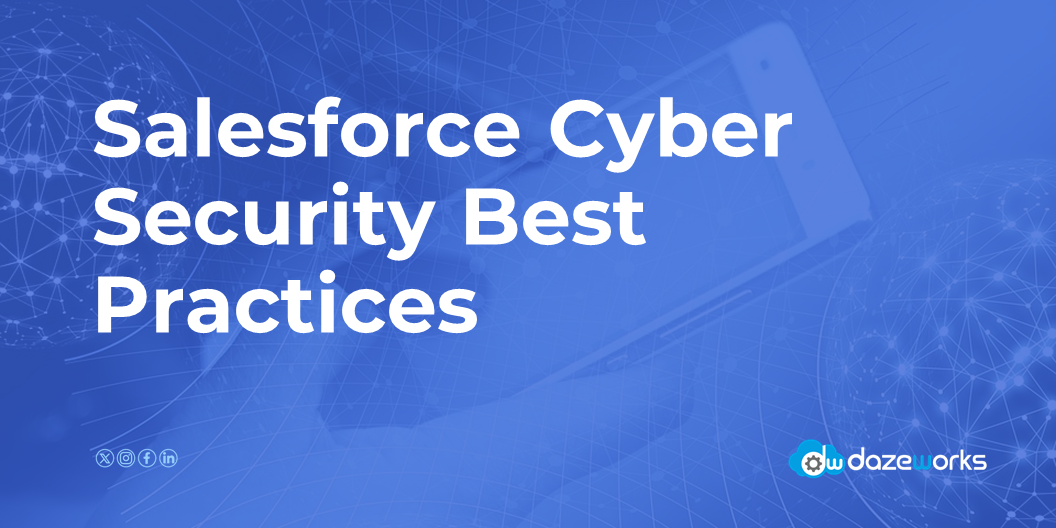
Salesforce Cybersecurity Best Practices
minutes read
With the proliferation of digital growth, one of the major concerns has been the explosion of cybersecurity threats. Every year, these attacks become more sophisticated, forcing companies to deal with serious repercussions. 90% of IT leaders face significant data security and governance challenges. When we talk about a domain like Salesforce that contains sensitive information, there are higher security threats. So how do you protect your Salesforce environment? Do you have the right strategy in place?
What is Cybersecurity?
Considering the amount of digital assets and information systems companies have, cybersecurity has become more crucial than ever. The phenomenon of cybersecurity goes beyond being vigilant and building strategies for the organization. It also includes embedding a sense of responsibility and accountability to each member of the organization. Cyberattacks are aimed at accessing, altering, and destroying sensitive information to extort money or impact business processes. Building a holistic cybersecurity strategy has become more challenging as technologies continue to expand.
What is Zero Trust Security?
In 2010, Zero Trust was coined at Forrester Research Inc. and backed by Zero Trust Network Access (ZTNA) as its primary technology. It is a security framework that requires all users within or outside the company’s network to be authorized, authenticated, and validated for security configurations before being granted access to data and applications. The framework is designed to secure infrastructure and data to facilitate safe digital transformation. It addresses modern business challenges such as hybrid cloud environments, ransomware threats, and securing remote workers. The Zero Trust security is built on the following principles:
- Least privilege
- Continuous monitoring and validation
- Device access control
- Preventing lateral movement
- Micro segmentation
- Multi-factor authentication
Building a Cybersecurity Strategy for Your Salesforce
Risk Assessment and Management
Begin by conducting a thorough risk assessment to identify potential vulnerabilities in your Salesforce environment. Evaluate the types of data stored, who has access, and how data flows through the system. Use this information to prioritize risks and develop a management plan.
Access Control and Identity Management
Implement robust access control measures to ensure that only authorized users can access your Salesforce data. Use role-based access controls (RBAC) to assign permissions based on job roles and responsibilities. Multi-factor authentication (MFA) is also crucial to enhance security by requiring multiple forms of verification.
Data Encryption
Salesforce provides encryption options to protect data both at rest and in transit. Ensure that encryption is enabled for sensitive data to prevent unauthorized access. Use Salesforce Shield for advanced encryption and event monitoring capabilities.
Regular Security Audits
Conduct regular security audits to identify and address potential security gaps. These audits should include vulnerability scanning, penetration testing, and security logs review. Regular audits help in maintaining a proactive security posture.
Compliance and Regulatory Requirements
Stay informed about relevant regulations and compliance standards that impact your industry. Ensure that your Salesforce implementation aligns with these requirements, such as GDPR, HIPAA, or CCPA, to avoid legal repercussions and fines.
Steps to Improve Your Cybersecurity Landscape
Enable Salesforce Shield
Salesforce Shield offers additional layers of security, including event monitoring, field audit trail, and platform encryption. These features provide deeper insights into user activities, track changes to data, and ensure compliance with encryption standards.
Implement Field-Level Security
Field-level security allows you to control access to specific fields within a record. By restricting access to sensitive information, you minimize the risk of unauthorized data exposure. Configure field-level security settings based on the principle of least privilege.
Utilize Security Health Check
Salesforce provides a Security Health Check tool to evaluate your security settings against Salesforce-recommended standards. Regularly use this tool to identify weaknesses in your security configuration and take corrective actions as needed.
Train Employees on Security Best Practices
Human error is often a significant factor in security breaches. Conduct regular training sessions to educate employees about cybersecurity best practices, such as recognizing phishing attempts, using strong passwords, and securely handling data.
Monitor and Respond to Security Events
Implement a robust monitoring system to detect and respond to security incidents promptly. Use Salesforce’s event monitoring and logging capabilities to track user activities and identify suspicious behavior. Establish an incident response plan to address potential security breaches effectively.
Regularly Update and Patch Systems
Keeping your Salesforce environment up-to-date with the latest patches and updates is critical to protect against known vulnerabilities. Regularly review and apply updates to Salesforce applications and any third-party integrations.
Leverage Third-Party Security Solutions
Consider integrating third-party security solutions to enhance your Salesforce security. Tools like data loss prevention (DLP) software, identity and access management (IAM) solutions, and advanced threat protection can provide additional layers of security.
Conclusion
Securing your Salesforce environment is an ongoing process that requires vigilance, proactive measures, and continuous improvement. By building a robust cybersecurity strategy and implementing the steps outlined in this blog, you can significantly enhance your cybersecurity landscape. Protecting your Salesforce data not only safeguards your organization, but also builds trust with your customers and stakeholders. Stay informed, stay prepared, and prioritize cybersecurity to ensure the resilience and integrity of your Salesforce environment.
